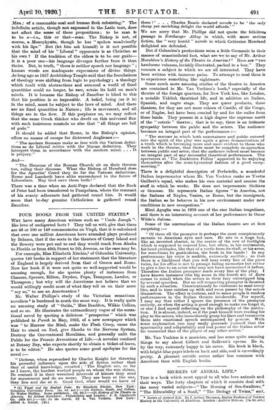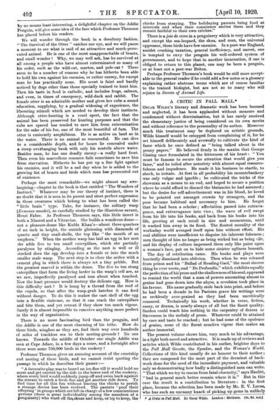SECRETS OF ANIMAL LIFE.*
Tars is a book which must appeal to all who love animals and their ways. The forty chapters of which it consists deal with the mosy varied subjects—" The Homing of Sea-Swallows," " The Educability of a Snail," " The Biology of Twins," and,
• Secrete of Animal Life. By J. Arthur Thomson. Regius Professor of Natural History in the University of Aberdeen. London : Andrew 31eirose. ITS, ed. net.]
by no means least interesting, a delightful chapter on the Addle Penguin, will give some idea of the fare which Professor Thomson has placed before his readers.
We will wander through the book in a desultory fashion. " The Survival of the Otter " catches our eye, and we will pause a moment to see what is said of an attractive and much-perse-
cuted animal. He is one of the most unapproachable of beasts, and small wonder ! Why, we may well ask, has he survived at all among a people who have almost exterminated so many of his order, such as the wild-cat, marten, and pole-cat ? There seem to be a number of reasons why he has hitherto been able to hold his own against his enemies, or rather enemy, for except man he has practically none. His scent is faint and hardly noticed by dogs other than those specially trained to hunt him. Then his taste in food is catholic, and includes frogs, salmon, and even, in times of emergency, wild-duck and rabbit. The female otter is an admirable mother and gives her cubs a sound education, supplying, by a gradual widening of experience, the liberating stimuli which are needed to develop their instincts.
Although otter-hunting is a cruel sport, the fact that the animal has been preserved for hunting purposes and that the cubs are spared has tended to save him from extermination for the sake of his fur, one of the most beautiful of furs. The otter is eminently amphibious. He is as active on land as in the water. There is no animal so resourceful. He can dive
to a considerable depth, and for hours lie concealed under a steep overhanging bank with only his nostrils above water.
Besides man, he has one deadly enemy—a really hard frost.
Then even his marvellous resource fails sometimes to save him from starvation. Hitherto he has put up a fine fight against his enemies, and it will be a sad day when he is added to the growing list of beasts and birds which man has persecuted out of existence.
Perhaps the most remarkable—we might almost say awe-
inspiring—chapter in the book is that entitled " The Wonders of Instinct." Whatever may be our theory of instinct, there is no doubt that it is seen in its purest and most perfect expression
in those creatures which belong to what has been called the " little brain " type. Take, for instance, the solitary wasp
(Eumenes amedei), so carefully studied by the illustrious savant, Henri Fabre. As Professor Thomson says, this little insect is
both a Nimrod and a Vitruvius. She builds a wondrous dome— not a pleasure-dome like Kubla Khan's—about three-quarters- of an inch in height, the outside glistening with diamonds of quartz and tiny snail-shells, the top like " the mouth of an amphora." When the mother wasp has laid an egg in her nest
she adds five to ten small caterpillars, which she partially paralyses by stinging. According as the nest is well or ill
stocked does the egg develop into a female or into the much smaller male wasp. The next step is to close the orifice with a cement plug in which there is always set a tiny pebble. But the greatest marvel is within the dome. The five to ten stung caterpillars that form the living larder in the wasp's cell are, as we saw, imperfectly paralysed and toss about when touched. Now the least pressure would destroy the delicate egg. How is this difficulty met ? It is hung by a thread from the roof of the cupola, so that after the wasp-grub hatches it can feed without danger. To do this it makes the cast shell of the egg
into a flexible staircase, so that it can reach the caterpillars
and bite them, and yet retreat if they show too much vigour. Surely it is almost impossible to conceive anything more perfect in the way of organization.
There is no more fascinating bird than the penguin, and the Adelie is one of the most charming of his tribe. How do these birds, wingless as they are, find their way over hundreds of miles of trackless sea to their nesting-grounds ? No one knows. Towards the middle of October one single Adelie was seen at Cape Adare, in a few days a score, and a fortnight after there were some 750,000 birds in the rookery !
Professor Thomson gives an amusing account of the courtship and nesting of these birds, and we cannot resist quoting the passage in which he describes their games :—
" A favourite play was to board an ice-floe till it would hold no more and get carried by the tide to the lower end of the rookery, where every bird would suddenly jump off and swim back against the stream to catch a fresh floe and get another ride down. To find time for all this fun without leaving the chicks to perish a strange device has been evolved. The parents 'pool their offspring ' in groups which are left in charge of a few conscientious persons (there is great individuality among the members of a penguinery) who ward off theoskuas and keep, or try to keep, the c. hicks from straying. The holidaying parents bring food at intervals and when their conscience smites them and they remain faithful to their own creches."
There is a joie de vivre in a penguinery which is very attractive, and except the sea-leopard, the skua, and man, the universal oppressor, these birds have few enemies. In a post-war England, amidst crushing taxation, general inefficiency, and unrest, one is tempted to envy the penguin his well-ordered system of government, and to hope that in another incarnation, if one is obliged to return to this planet, one may be born a penguin, or at least not a post-war Briton.
Perhaps Professor Thomson's book would be still more accept- able to the general reader if he could add a few notes or a glossary explaining rather abstruse terms which are of course familiar to the trained biologist, but are not so to many who will rejoice in Secrets of Animal Life.



































 Previous page
Previous page